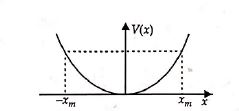Q.
The potential energy function for a particle executing linear $SHM$ is given by $V(x) = \frac{1}{2}kx^2$ where $k$ is the force constant of the oscillator. For $k = 0.5\, Nm^{-1}$, the graph of $V(x)$ versus x is shown in the figure. A particle of total energy $E$ turns back when it reaches $x = ± x_m$. If $V$ and $K$ indicate the potential energy and kinetic energy, respectively of the particle at $x = +x_m$, then which of the following is correct?
Work, Energy and Power
Solution: